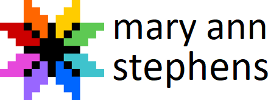October 16, 2019
This morning, someone wrote to me, hoping to knit some of my free Christmas Balls patterns but uncertain as to how to proceed with the charts. If you’re in the same boat, I think the following will not only help you decipher the charts, but just might make you a chart devotee:
Hi MaryAnn,
How are you?
Is there a written pattern for your Christmas balls? I can’t quite get the chart version.
Thanks,
No, I don't have a written pattern for any of the Christmas balls, mainly because, once you "get" the chart version, you won't want to suffer through the written pattern - the chart says it all, and much more succinctly – in the blink of an eye! I understand you don't feel that way right now; but, all you really need is a bit of help getting started with the charts and I'm happy to provide that.
First, did you read my brief article, "On Flat Charts for Round Shapes", on my Technique page? Lots of folks find it helpful. Here's a link right to the pdf:
Let's use my worsted weight "Two Strands Christmas Ball" mentioned in that little article as our example (below); the process is very similar with all of the balls.
Chart Row #1: The pattern starts by having you cast on 12 stitches, mentioning that 4 repeats of the chart equal 1 round of knitting. That means those 12 cast on stitches are shared across four chart repeats, so one of those 4 chart repeats will use 1/4th of your 12 cast-on stitches, or 3 stitches, and those are represented by the 3 starting stitch squares you see in the first row (with the numbers 1, 2 & 3 under them.) To work the 1st row, you just knit the 3 stitches showing for the 1st chart repeat, then do the same thing 3 more times for a total of 4 chart repeats, or what some might refer to as: "*K 3 sts, rep from * to EOR" or even more simply, "K 12 sts". Wherever you see plain squares all the way across the row, without any symbols, you simply knit the entire round.
Chart Row #2: As always, you start at the right side of the chart, i.e., column #1, and you knit across toward the left. As we saw in Row #1 (and in that little article I really hope you've read), that white space between columns #1 & #2 does not translate to space between the stitches on your needles - the column #1 & column #2 stitches on your needles always line up right next to each other, just like any other neighboring stitches. Here you have 3 knit stitches (the squares you see in row #2 / column #1, column #6 & column #7, right above your previous row), then you increase 1 st (by following the instructions for how to work the M symbol), for a total of 4 stitches within that first repeat; then, you work that same 4-stitch row (= K 3 sts, M 1 st) 3 more times for a total of 4 repeats and you'll end up with 4 x 4-st repeat = 16 stitches.
Chart Row #3: Notice that, just as in Row #1, there are only plain knit stitches here, no increasing (M or m) or decreasing (/ or \). Whenever you see rows without any shaping symbols, (M or m for increases and / or \ for decreases), you're simply knitting each stitch in your round, as you already saw in Row #1. So, for Row #3, you knit your 4 stitches for that repeat, then work them 3 more times for a total of 4 repeats = 4x4 = 16 stitches.
Chart Row #4: By now, you know to start at column #1 and we see that's a plain square, so it's a simple K stitch; next, we have a "m" increase; then, 3 plain K stitches, followed by an M increase at the end of the repeat. In other words, *K 1 st, m 1, K 3 sts, M 1, rep from * to EOR.
Beyond: As you work through the ball, you'll notice that weird, isolated column #1 (which you may have been cursing originally) has become both a useful landmark, since the shaping occurs on each side of it, and a nice design element, giving the ball symmetry. Just as the chart shows, column #1 forms a straight line from the ball's bottom to top, just like a meridian line on a globe.
I hope that helps, that you have a wonderful time knitting your Christmas balls and that you and your family have a glorious Christmas!
Copyright 2019, all rights reserved. Questions? Contact Mary Ann through her online yarn shop, MaryAnnStephens.com. Happy Knitting!


